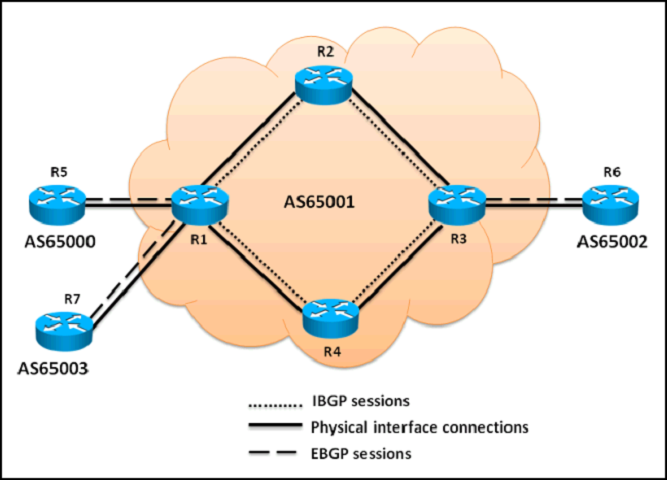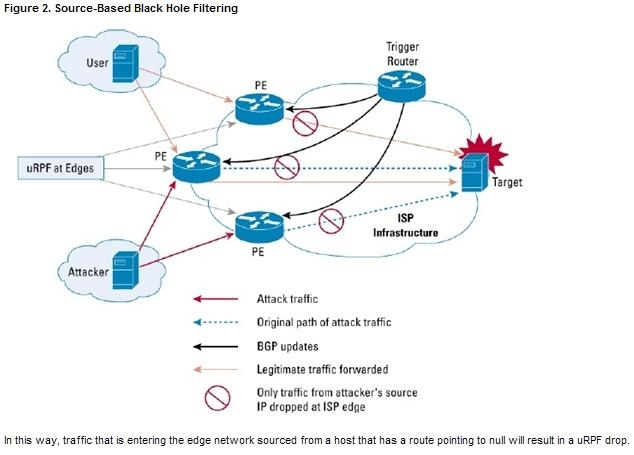Cisco® 642-885 Exam Practice Questions (P. 1)
- Full Access (131 questions)
- Six months of Premium Access
- Access to one million comments
- Seamless ChatGPT Integration
- Ability to download PDF files
- Anki Flashcard files for revision
- No Captcha & No AdSense
- Advanced Exam Configuration
Question #1
Referring to the topology diagram show in the exhibit,

which three statements are correct regarding the BGP routing updates? (Choose three.)

which three statements are correct regarding the BGP routing updates? (Choose three.)
- AThe EBGP routing updates received by R1 from R5 will be propagated to the R2, R4, and R7 routers
- BThe EBGP routing updates received by R3 from R6 will be propagated to the R2 and R4 routers
- CThe EBGP routing updates received by R1 from R5 will be propagated to the R2 and R4 routers
- DThe IBGP routing updates received by R3 from R2 will be propagated to the R6 router
- EThe IBGP routing updates received by R2 from R1 will be propagated to the R3 router
- FThe IBGP routing updates received by R1 from R4 will be propagated to the R5, R7, and R2 routers
Correct Answer:
ABD
ABD
send
light_mode
delete
Question #2
When a BGP route reflector receives an IBGP update from a non-client IBGP peer, the route reflector will then forward the IBGP updates to which other router(s)?
- ATo the other clients only
- BTo the EBGP peers only
- CTo the EBGP peers and other clients only
- DTo the EBGP peers and other clients and non-clients
Correct Answer:
C
C
send
light_mode
delete
Question #3
Which two BGP mechanisms are used to prevent routing loops when using a design with redundant route reflectors? (Choose two.)
- ACluster-list
- BAS-Path
- COriginator ID
- DCommunity
- EOrigin
Correct Answer:
AC
http://www.cisco.com/en/US/docs/ios_xr_sw/iosxr_r3.7/routing/configuration/guide/rc37bgp.html
As the iBGP learned routes are reflected, routing information may loop. The route reflector model has the following mechanisms to avoid routing loops:
Originator ID is an optional, nontransitive BGP attribute. It is a 4-byte attributed created by a route reflector.
The attribute carries the router ID of the originator of the route in the local autonomous system. Therefore, if a misconfiguration causes routing information to come back to the originator, the information is ignored.
Cluster-list is an optional, nontransitive BGP attribute. It is a sequence of cluster IDs that the route has passed. When a route reflector reflects a route from its clients to nonclient peers, and vice versa, it appends the local cluster ID to the cluster-list. If the cluster-list is empty, a new cluster-list is created. Using this attribute, a route reflector can identify if routing information is looped back to the same cluster due to misconfiguration. If the local cluster ID is found in the cluster- list, the advertisement is ignored.
AC
http://www.cisco.com/en/US/docs/ios_xr_sw/iosxr_r3.7/routing/configuration/guide/rc37bgp.html
As the iBGP learned routes are reflected, routing information may loop. The route reflector model has the following mechanisms to avoid routing loops:
Originator ID is an optional, nontransitive BGP attribute. It is a 4-byte attributed created by a route reflector.
The attribute carries the router ID of the originator of the route in the local autonomous system. Therefore, if a misconfiguration causes routing information to come back to the originator, the information is ignored.
Cluster-list is an optional, nontransitive BGP attribute. It is a sequence of cluster IDs that the route has passed. When a route reflector reflects a route from its clients to nonclient peers, and vice versa, it appends the local cluster ID to the cluster-list. If the cluster-list is empty, a new cluster-list is created. Using this attribute, a route reflector can identify if routing information is looped back to the same cluster due to misconfiguration. If the local cluster ID is found in the cluster- list, the advertisement is ignored.
send
light_mode
delete
Question #4
Which two statements correctly describe the BGP ttl-security feature? (Choose two.)
- AThis feature protects the BGP processes from CPU utilization-based attacks from EBGP neighbors which can be multiple hops away
- BThis feature prevents IBGP sessions with non-directly connected IBGP neighbors
- CThis feature will cause the EBGP updates from the router to be sent using a TTL of 1
- DThis feature needs to be configured on each participating BGP router
- EThis feature is used together with the ebgp-multihop command
Correct Answer:
AD
http://packetlife.net/blog/2009/nov/23/understanding-bgp-ttl-security/
AD
http://packetlife.net/blog/2009/nov/23/understanding-bgp-ttl-security/
send
light_mode
delete
Question #5
When implementing source-based remote-triggered black hole filtering, which two configurations are required on the edge routers that are not the signaling router? (Choose two.)
- AA static route to a prefix that is not used in the network with a next hop set to the Null0 interface
- BA static route pointing to the IP address of the attacker
- CuRPF on all external facing interfaces at the edge routers
- DRedistribution into BGP of the static route that points to the IP address of the attacker
- EA route policy to set the redistributed static routes with the no-export BGP community
Correct Answer:
AC
Source-Based RTBH Filtering -
With destination-based black holing, all traffic to a specific destination is dropped after the black hole has been activated, regardless of where it is coming from.
Obviously, this could include legitimate traffic destined for the target. Source-based black holes provide the ability to drop traffic at the network edge based on a specific source address or range of source addresses.
If the source address (or range of addresses) of the attack can be identified (spoofed or not), it would be better to drop all traffic at the edge based on the source address, regardless of the destination address. This would permit legitimate traffic from other sources to reach the target. Implementation of source-based black hole filtering depends on Unicast Reverse Path Forwarding (uRPF), most often loose mode uRPF.
Loose mode uRPF checks the packet and forwards it if there is a route entry for the source IP of the incoming packet in the router forwarding information base
(FIB). If the router does not have an FIB entry for the source IP address, or if the entry points to a null interface, the Reverse Path Forwarding (RPF) check fails and the packet is dropped, as shown in Figure 2. Because uRPF validates a source IP address against its FIB entry, dropping traffic from specific source addresses is accomplished by configuring loose mode uRPF on the external interface and ensuring the RPF check fails by inserting a route to the source with a next hop of Null0.
This can be done by using a trigger device to send IBGP updates. These updates set the next hop for the source IP to an unused IP address that has a static entry at the edge, setting it to null as shown in Figure 2.

AC
Source-Based RTBH Filtering -
With destination-based black holing, all traffic to a specific destination is dropped after the black hole has been activated, regardless of where it is coming from.
Obviously, this could include legitimate traffic destined for the target. Source-based black holes provide the ability to drop traffic at the network edge based on a specific source address or range of source addresses.
If the source address (or range of addresses) of the attack can be identified (spoofed or not), it would be better to drop all traffic at the edge based on the source address, regardless of the destination address. This would permit legitimate traffic from other sources to reach the target. Implementation of source-based black hole filtering depends on Unicast Reverse Path Forwarding (uRPF), most often loose mode uRPF.
Loose mode uRPF checks the packet and forwards it if there is a route entry for the source IP of the incoming packet in the router forwarding information base
(FIB). If the router does not have an FIB entry for the source IP address, or if the entry points to a null interface, the Reverse Path Forwarding (RPF) check fails and the packet is dropped, as shown in Figure 2. Because uRPF validates a source IP address against its FIB entry, dropping traffic from specific source addresses is accomplished by configuring loose mode uRPF on the external interface and ensuring the RPF check fails by inserting a route to the source with a next hop of Null0.
This can be done by using a trigger device to send IBGP updates. These updates set the next hop for the source IP to an unused IP address that has a static entry at the edge, setting it to null as shown in Figure 2.

send
light_mode
delete
All Pages
